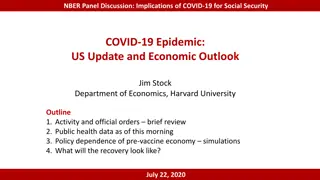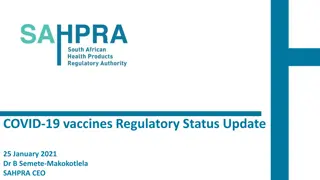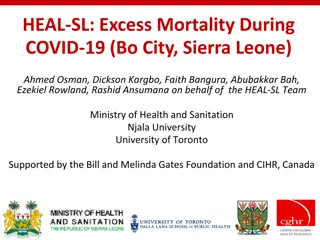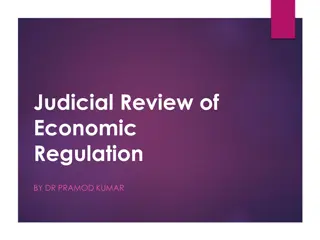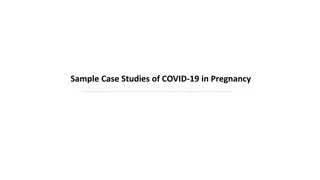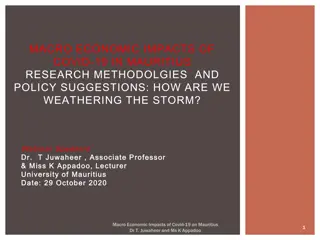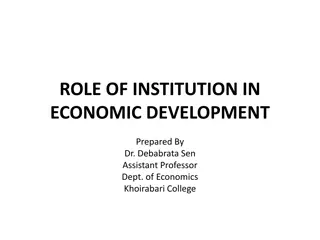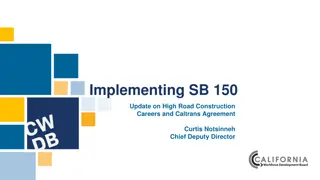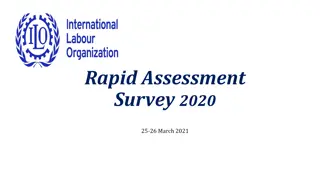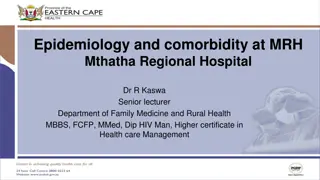UK Economic Activity Update: Impact of COVID-19
UK's economic activity and output have seen significant impacts due to the COVID-19 pandemic. While GDP has shown signs of recovery, it remains below pre-pandemic levels. Weekly hours worked have increased but are still below pre-pandemic levels, and the number of payrolled employees is gradually rising. Employment rates have seen a quarterly increase, while redundancies and job vacancies reflect fluctuations in the job market. Overall, the UK economy continues to navigate through the challenges posed by COVID-19.
Download Presentation

Please find below an Image/Link to download the presentation.
The content on the website is provided AS IS for your information and personal use only. It may not be sold, licensed, or shared on other websites without obtaining consent from the author. Download presentation by click this link. If you encounter any issues during the download, it is possible that the publisher has removed the file from their server.
E N D
Presentation Transcript
Economic Impacts of COVID-19: Summary Understanding the impacts of COVID-19 Summary Update Prepared by Economy & Planning: Research & Intelligence Team Updated November 2021
UK economic activity: GDP Economic activity and output have fallen significantly, but beginning to recover UK gross domestic product (GDP) is estimated to have increased by 1.3% in Quarter 3 (Jul to Sept) 2021 following the continued easing of COVID-19 restrictions. The level of quarterly GDP is now 2.1% below where it was before the coronavirus pandemic. Source: ONS quarterly estimate (Next release: 22 December 2021)
UK economic activity: weekly hours worked Total actual weekly hours worked in the UK increased by 25.2 million hours on the quarter, to 1.03 billion hours in July to September 2021, however, this is still 25.6 million below pre- pandemic levels These statistics are affected directly by changes in the number of people in employment and in the number of hours that people work. Source: ONS employment (Next release: 14 December 2021)
UK economic activity: payrolled employees Early estimates for October 2021 indicate that the number of payrolled employees rose by 4.0% compared with October 2020, a rise of 1,139,000 employees There were 160,000 more people were in payrolled employment in October 2021 when compared with the previous month. The number of payrolled employees is up by 0.8% since before the pandemic (February 2020), a rise of 235,000. Since the start of 2021, growth rates in PAYE have started to recover, although this is partly due to the reduction of employees between Mar May 2020. Source: ONS PAYE (Next release: 14 December 2021)
UK employment rates July to September 2021 estimates a quarterly increase in the employment rate, while the unemployment rate decreased, and the economic inactivity rate was largely unchanged. The employment rate was estimated at 75.4%, 1.1 percentage points lower than before the coronavirus pandemic, but 0.4 percentage points higher than the previous quarter (April to June 2021). The UK unemployment rate was estimated at 4.3%, 0.3 percentage points higher than before the pandemic, but 0.5 percentage points lower than the previous quarter. Source: ONS employment (Next release: 14 December 2021)
UK Redundancies and Vacancies The number of job vacancies in August to October 2021 continued to rise to a new record of 1,172,000, an increase of 388,000 from pre-pandemic levels. In July to September 2021, reports of redundancies in the three months prior to interview increased by 0.2 per thousand on the quarter to 3.7 per thousand employees, similar to pre-pandemic levels. Sources: ONS employment (Next release: 14 December 2021); ONS vacancies (Next release: 14 December 2021)
South West Labour Market- Headline Indicators The overall employment rate in the South West stands at 78.8% from July-September 2021, an increase of 2.2 percentage points from June-August 2020 and an increase of 1.7 percentage points from the previous quarter. This employment rate is higher than the UK average of 75.4%. The unemployment rate stands at 3.3% in the South West from July-September, the lowest rate in the UK. This is 0.9 percentage points lower than the same time last year, and 0.3 percentage points lower than the previous quarter. The economic inactivity rate for July-September 2021 in the South West stands at 18.4%, a -1.6 percentage point change from the previous quarter and 1.5 percentage point decrease from the previous year. Source: ONS Labour market (Next release: 14 December 2021) Employment rate (%) aged 16 to 64 years Change on April to June 2021 (percentage point change) Change on July to September 2020 (percentage point change) Unemployment rate (%) aged 16 years and over Change on April to June 2021 (percentage point change) Change on July to September 2020 (percentage point change) Inactivity rate (%) aged 16 to 64 years Change on April to June 2021 (percentage point change) Change on July to September 2020 (percentage point change) UK 0.4 0.4 4.3 -0.5 -0.6 21.1 0.0 0.1 75.4 South West 1.7 2.2 3.3 -0.3 -0.9 18.4 -1.6 -1.5 78.8
South West Labour Market headline indicators In the South West, estimates for October 2021 state there were 2,457,077 payrolled employees, up from 2,448,763 in September 2021. Estimates show the total number of people aged 16-64 in employment in July-September 2021 decreased 0.1% from the previous year. Source: ONS PAYE; ONS Labour market In comparison, estimates for the UK indicate 29.4 million payrolled employees in October, a rise of 4% compared with October 2020.
Economic impact on young people 475,000 young people aged 16-24 were unemployed in July- September 2021, a decrease of 54,000 from the previous quarter and a decrease of 131,000 from the year before The unemployment rate for 16-24 year olds was 11.7% in July- September 2021. This is down from 13.1% in the previous quarter and down from 14.8% a year before. Whilst youth unemployment has consistently tracked higher than the aggregate unemployment rate, the over-representation of young people in vulnerable sectors such as accommodation and retail have led to a susceptibility to job losses or furloughing. Youth Unemployment VS. Unemployment, October 2019 - July 2021, Seasonally Adjusted 16.0 14.0 12.0 10.0 8.0 Sources: UK parliament Youth unemploym ent ; ONS Labour market (Next release: 14 December 2021) See below notes for further info. 6.0 4.0 2.0 0.0 Unemployment rate (16-64) Youth Unemployment rate (18-24)
Somerset claimant counts Claimant Count as a Proportion of Residents 7.0 There has been a steep rise in the claimant count across Somerset since the start of the pandemic, peaking in August 2020 with 5.2% of Somerset s working age population claiming out-of-work benefits. Since then, rates have dropped, with figures for October 2021 showing 3.4% of the working age population in Somerset were claiming out-of-work benefits. Somerset had consistently lower claimant rates than the national average before the crisis and this remains the case. Please Note: Claimant count figures do NOT provide a direct measure of unemployment and claimant conditionalities were relaxed in response to the COVID-19 crisis. 6.0 5.0 4.0 3.0 2.0 1.0 0.0 January 2020 February 2020 January 2021 February 2021 May 2020 May 2021 October 2019 November 2019 August 2020 October 2020 November 2020 August 2021 June 2020 June 2021 December 2019 March 2020 July 2020 December 2020 March 2021 July 2021 April 2020 April 2021 September September 2020 October Mendip Sedgemoor SWT South Somerset Somerset South West United Kingdom Change from pre- pandemic (March 2020) (percentage points) South West CC as a proportion of residents Change from pre-pandemic (March 2020) (percentage points) Somerset CC as a proportion of residents Change from pre-pandemic (March 2020) (percentage points) Source: ONS CC (Next release: 14 December 2021) UK CC as a proportion of residents October 2021 4.8 +2 3.5 +1.4 3.4 +1.2
Somerset Business Survey 2021 results Difficulties sourcing materials and/or services as a result of Data collected from Somerset businesses throughout April-May of 2021 has demonstrated Somerset s businesses have been significantly impacted by COVID-19. 47% of businesses reported achieving 50% or less of their turnover in the last 12 months, whilst 53% reported achieving 50% or less of normal profitability levels. 78.6% of businesses reported cash flow as constituting a key challenge to their business over the last 12 months, with 87.1% reporting that uncertainty of future public health restrictions had constituted a challenge. 93% of businesses reported an impact on sourcing materials/services as a result of both COVID-19 and/or Britain s exit from the EU. Despite this, over 60% of businesses described their current outlook as either very or fairly positive. 7% 33% 60% Britain's exit from the European Union COVID-19 related impacts and/or restrictions Other How would you describe the current outlook for your business? 60% 48% 50% 40% Source: SCC Covid-19 economic impacts 30% 24% 20% 12% 11% 10% 2% 2% 0% Very positive Fairly positive Neutral Fairly negative Very negative Don't Know
UK furlough numbers Latest figures show that there were 410,000 employers with 1.14 million staff on furlough on 30 September 2021. This is a decrease of 210,000 jobs from 31 August when there were 1.35 million employments on furlough. Since the start of the scheme a total of 11.7 million jobs have been put on furlough for at least part of the duration of the scheme. The levels of furlough seen in the graph reflect the changes to restrictions on individuals, households and businesses across the UK over time Source: HMRC CJRS (next release: 16 December 2021)
UK Furlough by sector Provisional figures show that all sectors saw a reduction in levels of furlough between 31 August and 30 September. The Other services activities industry (including Agriculture, energy production, social security and education etc) had the highest proportion of employments on furlough at 30 September 2021). the accommodation and food services sector saw the largest reduction in the number of employments on furlough between 31 August and 30 September (down by 43,000), although 9% of eligible employments in this sector were still on furlough at the end of September Industry groups among those related to travel and tourism had the highest take- up rates at 30 September 2021: notably passenger air transport (36%) and travel agency and tour operator activities (35%). Take-up rate at 30 September (provisional) Other service activities 11.0% Arts, entertainment and recreation 9.0% Accommodation and food services 9.0% Transportation and storage 7.0% Construction 7.0% Administrative and support services 5.0% Professional, scientific and technical 5.0% Real estate 5.0% Manufacturing 5.0% National Average 4% Information and communication 4.0% Wholesale and retail; repair of motor vehicles 4.0% Water supply, sewerage and waste 2.0% Agriculture, forestry and fishing 2.0% Source: ONS CJRS (Next release: 16 December 2021) Households 1.0% Health and social work 1.0% Education 1.0% Finance and insurance 1.0% Mining and quarrying 1.0% Public administration and defence; social security 0.5% Energy production and supply 0.5% 0.0% 2.0% 4.0% 6.0% 8.0% 10.0% 12.0%
SEISS Grants Proportion of total value of claims made October 2021 28.1 billion has been paid in SEISS grants in total (up to 7 October 2021). Across the 5 grants 2.9 million individuals have received a grant and 10.4 million total grants have been claimed. The sector with the highest number of potentially eligible individuals and the highest proportion of claims is the construction industry. By 7 October, construction workers had made 427,000 claims for the fifth grant, totalling 1.1 billion. Construction is the largest sector among the self-employed population with 1.2 million individuals assessed for eligibility Construction 38% Unknown and other 13% Transportation and storage 10% Other service activities 8% Professional, scientific and technical activities 5% Administrative and support service activities 5% Wholesale and retail trade; repair of motor vehicles and motorcycles 4% Education 4% Arts, entertainment and recreation 4% Human health and social work activities 3% Manufacturing 2% Accommodation and food service activities 2% Information and communication 1% Agriculture, forestry and fishing 1% Real estate activities 0% Source: HMRC SEISS Public administration and defence; compulsory social security 0% Financial and insurance activities 0% 0% 5% 10% 15% 20% 25% 30% 35% 40%
Furlough in Somerset Employments on furlough by sector in Somerset, at 30 September The largest proportionate reduction of the number of employments on furlough in September was in the South West As of the 31st of August 2021, 8,300 employments had been furloughed in Somerset (4% take-up rate), a significant drop from the 78,300 employments furloughed at the end of July 2020 (a take-up rate of 30%). Other 360 Other service activities 370 Arts, entertainment and recreation 250 Health and social work 230 Administrative and support services 520 Professional, scientific and technical 740 Information and communication, Financial and insurance & Real estate 430 Accommodation and food services 940 Transportation and storage 460 Source: HMRC CJRS (Next release: 16 December 2021) Wholesale and retail; repair of motor vehicles 1,060 Construction 590 Manufacturing 730 0 200 400 600 800 1,000 1,200
Business Impact Survey insights Headline Industry Insights: The percentage of currently trading businesses has fallen slightly from 93% in late October 2021, to 91% in early November 2021 Of businesses currently trading, 28% reported a decrease in turnover, up from 24% in late September 2021, and is the highest percentage since early August 2021. Of businesses not permanently stopped trading, 6% reported no or low confidence that they would survive the next 3 months, compared with 4% reported in early October 2021 Workforce: Approximately 17% of the workforce were estimated to be using a hybrid model of working in late October; this increased to over a fifth (21%) of the workforce in businesses with 100 employees or more. The information and communication industry reported the highest proportion of its employees using a hybrid model of working at 38% in late October 2021 The proportion of the workforce estimated to be working from a designated workspace in the last two weeks was 61%, while 12% were estimated to be working from home. 50% of businesses reported their workforce had already returned to their normal place of work in early November 2021; this has increased from 34% in early September 2021 The information and communication industry reported the highest percentage of all businesses intending to use increased homeworking as a permanent business model, at 51%. Source: ONS Business insights (Next release: 2 December 2021
Challenges by industry Retail: Retail sales volumes rose by 0.8% in October 2021, from a revised unchanged (0.0%) position between August and September. Volumes were 5.8% higher than their pre-pandemic levels (February 2020). Non-food stores was the only main retail sector that saw a rise in sales volumes, increasing by 4.2% in October 2021 Automotive fuel sales volumes fell by 6.4% in October 2021, 5.0% below their February 2020 levels The proportion of retail sales online fell to 27.3% in October 2021, its lowest proportion since March 2020 (22.5%) Accommodation & Food Services: 91.4% of businesses in the accommodation and food services sector were currently trading in early November 2021. 38.5% of businesses in November reported that turnover had decreased compared with normal expectations for this time of year. Health & Social Care Activities: 100% of businesses in the health and social care sector were currently trading between 1 and 14 November 2021. Sources: ONS retail (Next release: 17 December 2021); ONS Business Insights (Next release: 2 December 2021)
Challenges by industry Manufacturing The manufacturing sector fell by 0.1% in September 2021, following revised 0.3% growth in August 2021 Most of the contribution to manufacturing falling was because of a 5.1% decrease in the manufacture of transport equipment. Output in the manufacture of motor vehicles fell by 8.2% in September 2021, the largest fall since May 2021 Regionally, the SWMAS barometer highlighted the challenges of the pandemic, although some metrics are improving strongly for the manufacturing industry. Encouragingly, 46% of those questioned are now trading at increased levels when compared to their pre- COVID-19 position. However, trade still hasn t returned to pre-pandemic levels for 40% of the South West businesses who responded this quarter. Construction Construction output increased by 1.3% in September 2021 following two consecutive months of contraction. The growth in monthly construction output in September 2021 was driven by an increase in repair and maintenance (1.2%) and new work (1.3%). Construction output recently peaked to be 0.9% above its pre-coronavirus (COVID-19) pandemic level in April 2021 but in September 2021 is now 1.0% below its pre-coronavirus pandemic level Source: ONS GDP (Next release: 10 December 2021)
Job postings in Somerset There were 153,126 total job postings in Somerset in October 2021, of which 26,198 were unique. This is an increase from pre-pandemic levels; there were 17,646 unique postings in March 2020. Throughout the onset of the pandemic since March, demand for workers in the health & social care industry has remained consistently strong. Unique postings in August were predominantly for nurses (1,303) and care home workers (1,174), highlighting the strong demand from the health & social care sector. Please Note: Job postings are a noisy but useful/timely indicator of labour demand in the economy, whereas more rigorous statistical data is less quickly available. In addition, some postings may be double counted thereby inflating posting figures Occupation Unique Job postings (August 2021) Nurses 1,303 Care workers and home carers 1,174 Van Drivers 765 Elementary storage occupations 729 Kitchen and Catering Assistants 710 Sales and Retail Assistants 684 Cleaners and Domestics 584 Other Administrative Occupations n.e.c. 514 Chefs 702 Source: Emsi job postings Sales Accounts and Business Development Managers 473
Economic and Fiscal Outlook In October 2021, the Office for Budget Responsibility published their Economic and fiscal outlook. Headlines: The economy is expected to grow by 6.5 per cent in 2021 (2.4 percentage points faster than predicted in March) Unemployment is expected to rise only modestly to 5 per cent this winter (1 percentage points lower than March) The budget deficit almost halved to 183 billion in 2021-22 ( 51 billion lower than March). CPI inflation is expected to reach 4.4 per cent next year Short / medium term expectations: In the UK, supply bottlenecks have been exacerbated by changes in the migration and trading regimes following Brexit. Energy prices have soared, labour shortages have emerged in some occupations, and there have been blockages in some supply chains. These are likely to hold back output growth in the coming quarters. Limited evidence as yet around how smoothly furloughed workers will be reabsorbed into employment, or whether those workers who became inactive during the pandemic will re-enter the labour force. With inflation also higher and more persistent, nominal GDP the key driver of tax revenues has been revised up by 4.1 per cent in 2025-26 relative to March While higher inflation also boosts public spending, overall pre-measures forecast for borrowing is lower by 38 billion a year on average relative to the March forecast. Source: OBR
Economic and Fiscal Outlook GDP is expected to grow by 6.5 per cent in 2021 and to regain its pre-pandemic level around the turn of the year. Output fell by only 2.4% in January, much lower than predicted in the March forecast (4.7%) Due to the rollout of vaccines and the lifting of public health restrictions, output was just 1.1% below its pre-pandemic peak in August 2021, rather than the 4.9% shortfall expected in the March forecast. The pace of growth is expected to continue moderating over the remainder of the year and into next (due to supply bottlenecks, fiscal support withdrawn, higher case numbers etc). Source: OBR
Labour Market implications for recovery The Coronavirus Job Retention Scheme (CJRS) ended on 30 September 2021, and 1.3 million jobs were still on furlough as at 31 August. The number of jobs that are furloughed has been gradually falling since the end of January when 4.9 million jobs were furloughed. The Treasury s July 2021 survey of independent forecasts for the unemployment rate showed an average forecast of 5.2% for Q4 2021 and 4.7% for Q4 2022. In its March 2021 Economic and fiscal outlook, the OBR projected that unemployment will peak at 6.5% (2.2 million) in Q4 2021, once the CJRS has closed. The unemployment rate is projected to then decrease slowly, reaching 5.0% (the rate in Q4 2020), again by Q3 2023 Actions needed: Policies that stimulate labour demand can prevent excessive unemployment Augmented training to support reallocation of workers and to upskill those at risk of displacement. To make digital service provision more inclusive going forward, further efforts are needed to ensure that all individuals have the skills and access to technology needed to benefit from these services. Sources: HoC Library labour market; OECD Policy responses






